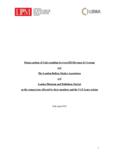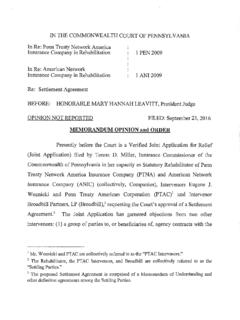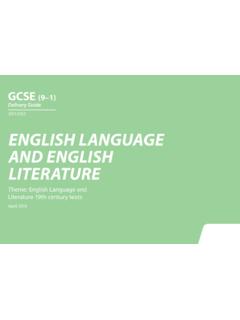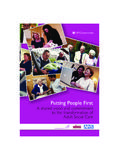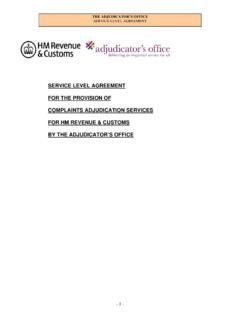Transcription of Memorandum of Understanding between the …
1 Memorandum of Understanding between the coroners society of England and Wales and the Health and Safety ExecutiveIntroduction This Memorandum records an agreement between the coroners society of England and Wales and the Health and Safety Executive (HSE). It is intended to promote and continue effective working relationships between coroners and HM Inspectors of Health and Safety, with the object of fostering constructive co-operation. Nature of the agreement The Memorandum describes a voluntary agreement. The parties to it recognise that coroners are independent judicial officers.
2 The agreement is not binding and is not intended to create any legally enforceable rights, obligations or restrictions. Aims To promote consistency, with the intention that this will allow coroners and HSE to discharge their different and independent statutory functions and to use their limited resources to best effect. To set out clearly the level of assistance that HSE can legitimately provide to the Coroner following a work-related death. To promote the wider public interest of holding effective inquests into deaths at, or arising from, work without prejudicing ongoing investigations or criminal proceedings.
3 Basis for co-operation This Memorandum recognises that coroners and HSE have limited resources. HSE is resourced with the aim of protecting people s health and safety, by ensuring that risks in the workplace are properly controlled in accordance with its statutory functions, as set out in the Health and Safety at Work etc. Act 1974 (HSWA). The parties recognise that coroners and HSE have different roles and responsibilities in relation to work-related deaths. HSE (or another relevant enforcing authority) will investigate and, where appropriate, prosecute breaches of health and safety law under the HSWA.
4 HSE does not investigate or prosecute unlawful killing, or any other criminal offences outside its health and safety remit. The Coroner alone is responsible for deciding on the scope or ambit of the inquest. The Coroner must ensure that the relevant facts are fully and fairly investigated and are the subject of public scrutiny during the inquest hearing. The wider public interest also includes the need to ensure that the risk of prejudice to any ongoing investigation and potential criminal proceedings is minimised. 1 The Coroner may request assistance from HSE.
5 It is HSE s policy to assist a Coroner wherever possible. This agreement recognises that such assistance is incidental to, and not a part of, HSE s function. The statutory responsibility for ascertaining the identity of the deceased, and when, where and how they came by their death, remains with the Coroner. HSE can only investigate within the authority granted by the HSWA. coroners and HSE have agreed to work cooperatively in the interests of justice, recognising their different statutory roles, to resolve any differences or conflicts. This Memorandum provides a best practice framework to achieve this; but it recognises that there may be certain occasions when a more formal approach to resolving issues is of the agreement This Memorandum of Understanding (MoU) was drafted following discussions between the parties regarding identified best practice.
6 The parties accept that HSE assistance to coroners avoids unnecessary duplication of effort. Whilst the statutory regime allows for evidence to be called at a hearing, the arrangements set out in this MoU benefit the inquest by providing for information to be shared with the Coroner in advance. The parties also agree that HSE has limited resources with which to meet its core responsibilities and strategic priorities. Any assistance to the Coroner is incidental to, and not a part of, its function. The parties recognise that, for the purposes of ensuring an effective and consistent approach to its investigations, HSE provides guidance to its Inspectors.
7 This is set out in the HSE Enforcement Guide at: HSE s Enforcement Guide is a publicly available document which sets out guidance for Inspectors on investigating and prosecuting breaches of health and safety law. The Guide contains advice on working with coroners , setting out best practice in the investigation of workplace fatalities and co-operation with other investigatory bodies. The parties understand that this guidance will be updated from time to time and that the best source is therefore to be found at the above website address. Investigation The Enforcement Guide sets out the different roles of the Coroner, HSE, police and Crown Prosecution Service (CPS) and their responsibilities in relation to work-related deaths.
8 The guidance it gives is consistent with the Work-Related Deaths Protocol (WRDP). The coroners society has undertaken to adopt an approach to HSE investigations similar to the way they treat police investigations: ie Inspectors can be confident that coroners will only use those parts of witness statements, reports and other investigation material which are necessary for the purposes of the inquest. coroners will have regard to the fact that HSE may need to undertake further enquiries (including the taking of additional witness statements) and, given that criminal proceedings might arise from the same subject matter, they will avoid wholesale disclosure of investigatory material.
9 The coroners society recognises the possible complications that can be presented by the implications of the employer-employee relationship that commonly exists in health and safety investigations. 2 The parties to this Memorandum recognise that HSE investigations are restricted by virtue of the HSWA. HSE Inspectors have their own statutory powers. coroners will not attempt to direct HSE s investigations. coroners and/or their officials need to be kept informed of the progress of those enquiries. HSE will, therefore, regularly keep the Coroner informed as to progress of their investigation and discuss issues arising from the investigation (that are relevant to the inquest).
10 There should be an early discussion between HSE and the Coroner after HSE takes primacy for the investigation as to: the likely timescales for the investigation; timing of any inquest; chronology of any legal proceedings; and how and when future updates will be provided. This will enable the Coroner to pursue any separate lines of enquiry, or to take additional statements, that they consider necessary for their inquest. Chronology of proceedings The Enforcement Guide also advises that, once an investigation is complete, HSE will consider whether to bring any criminal proceedings against any organisation or person.










